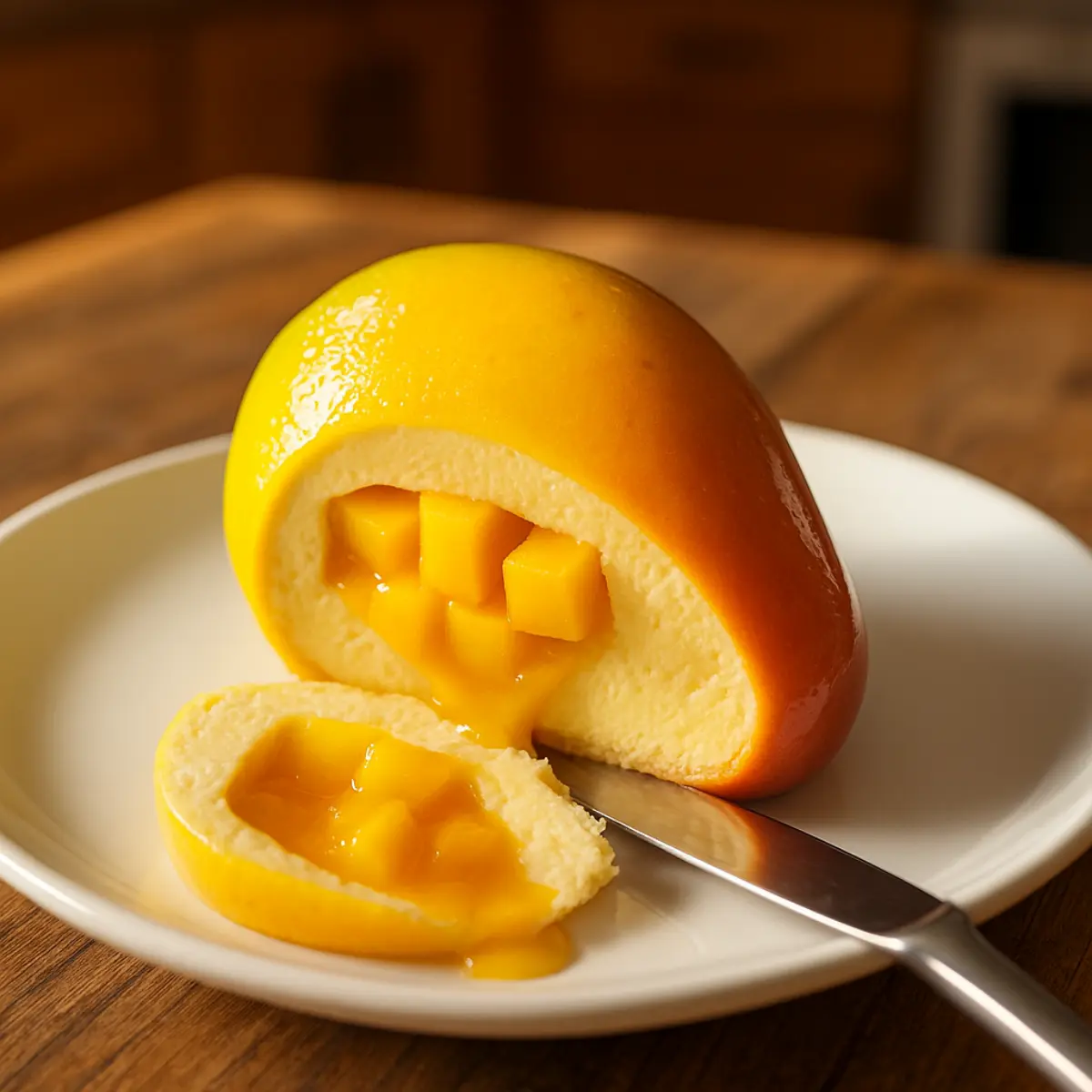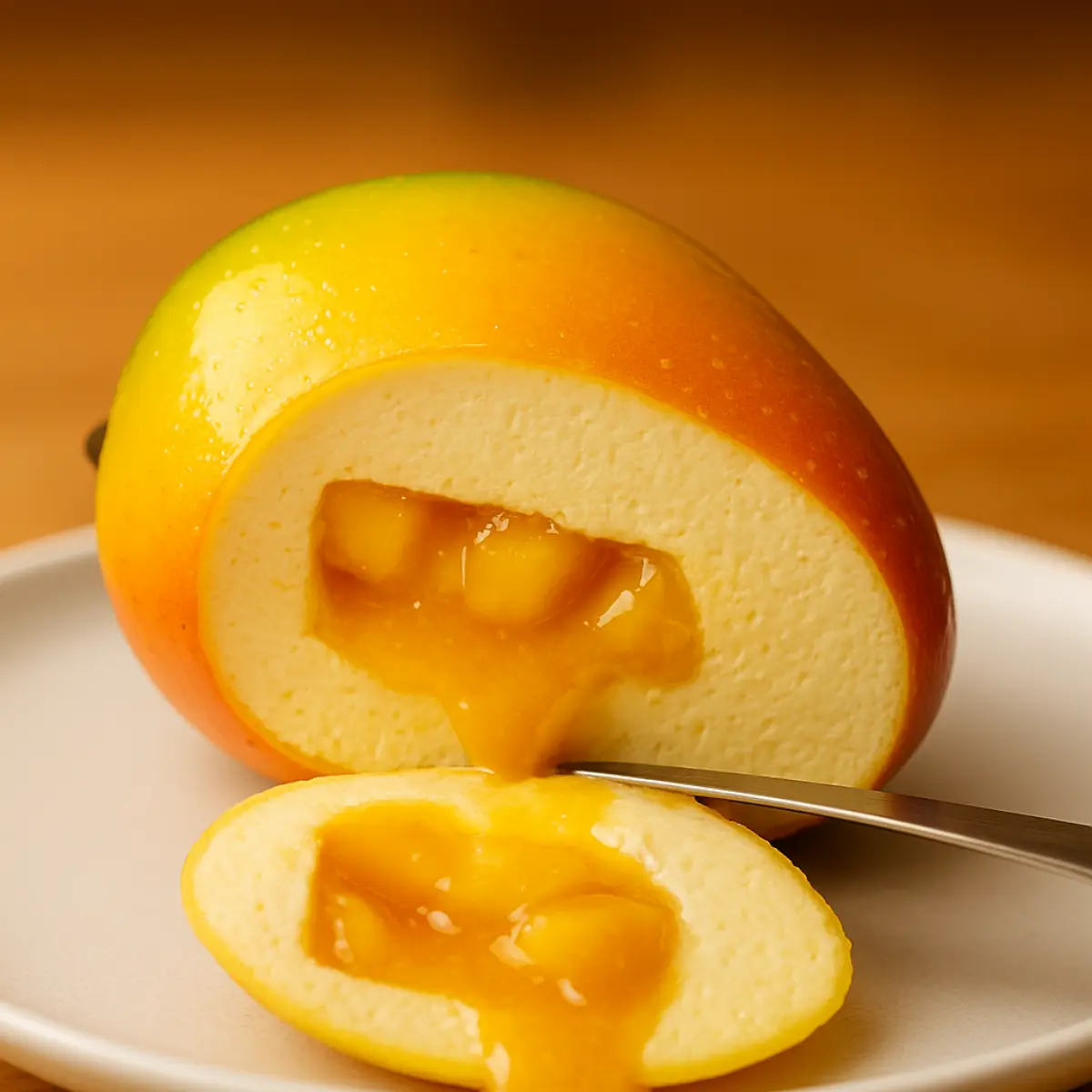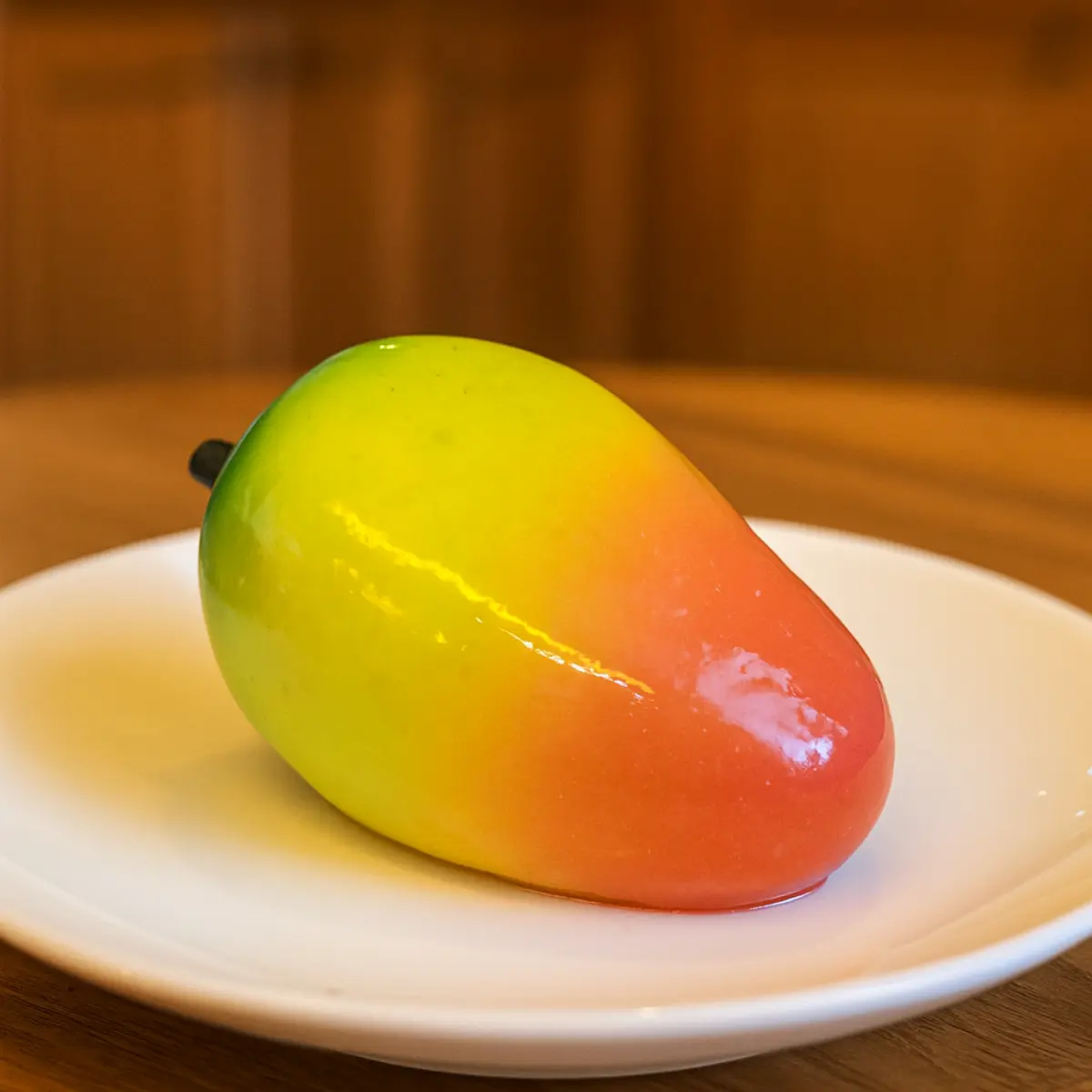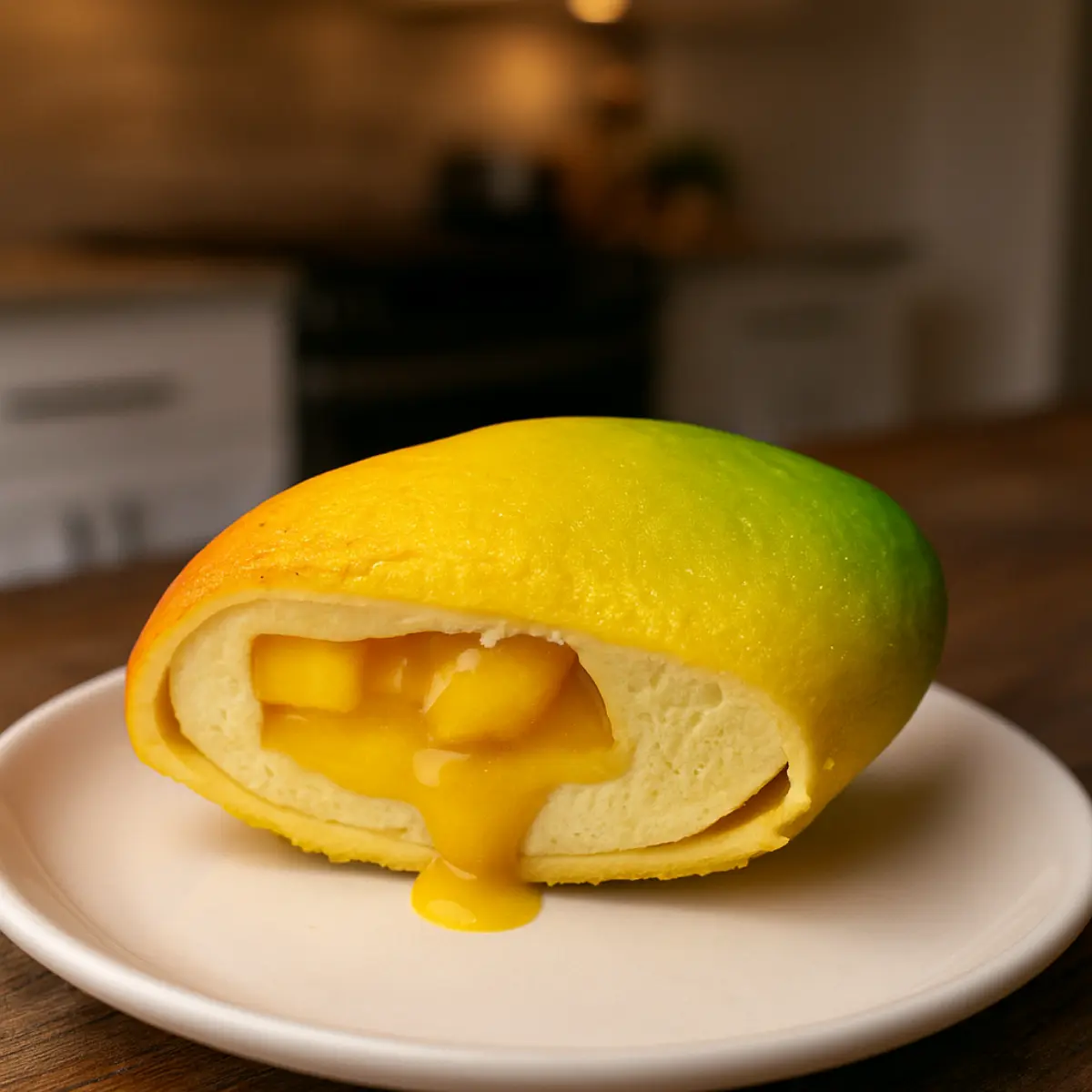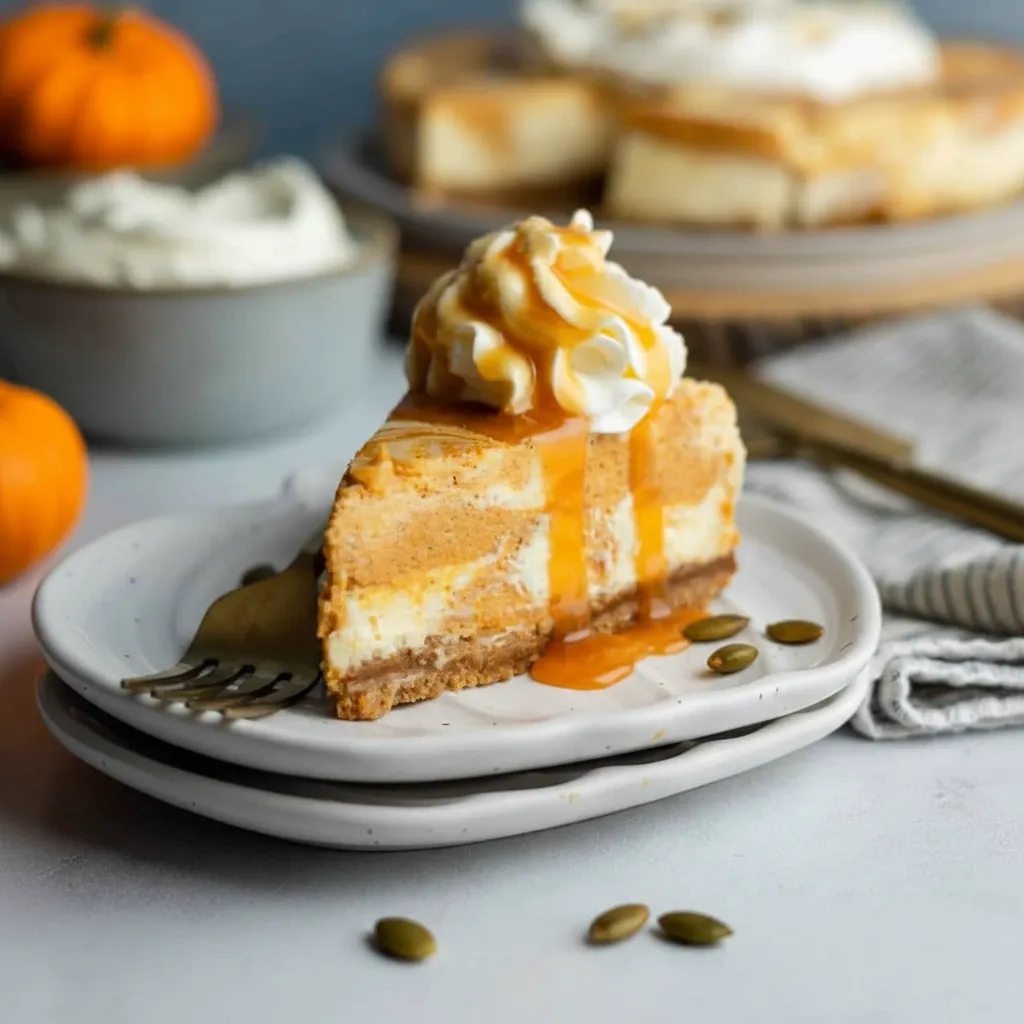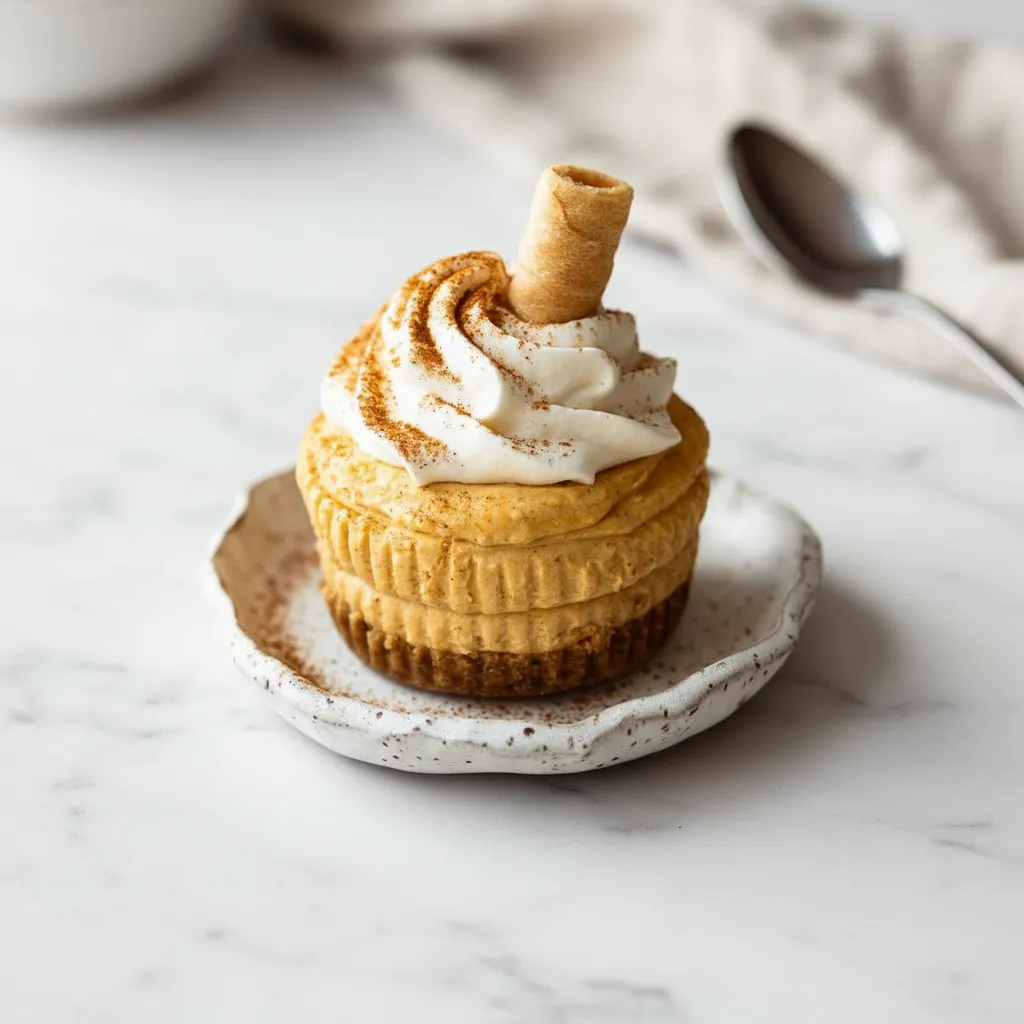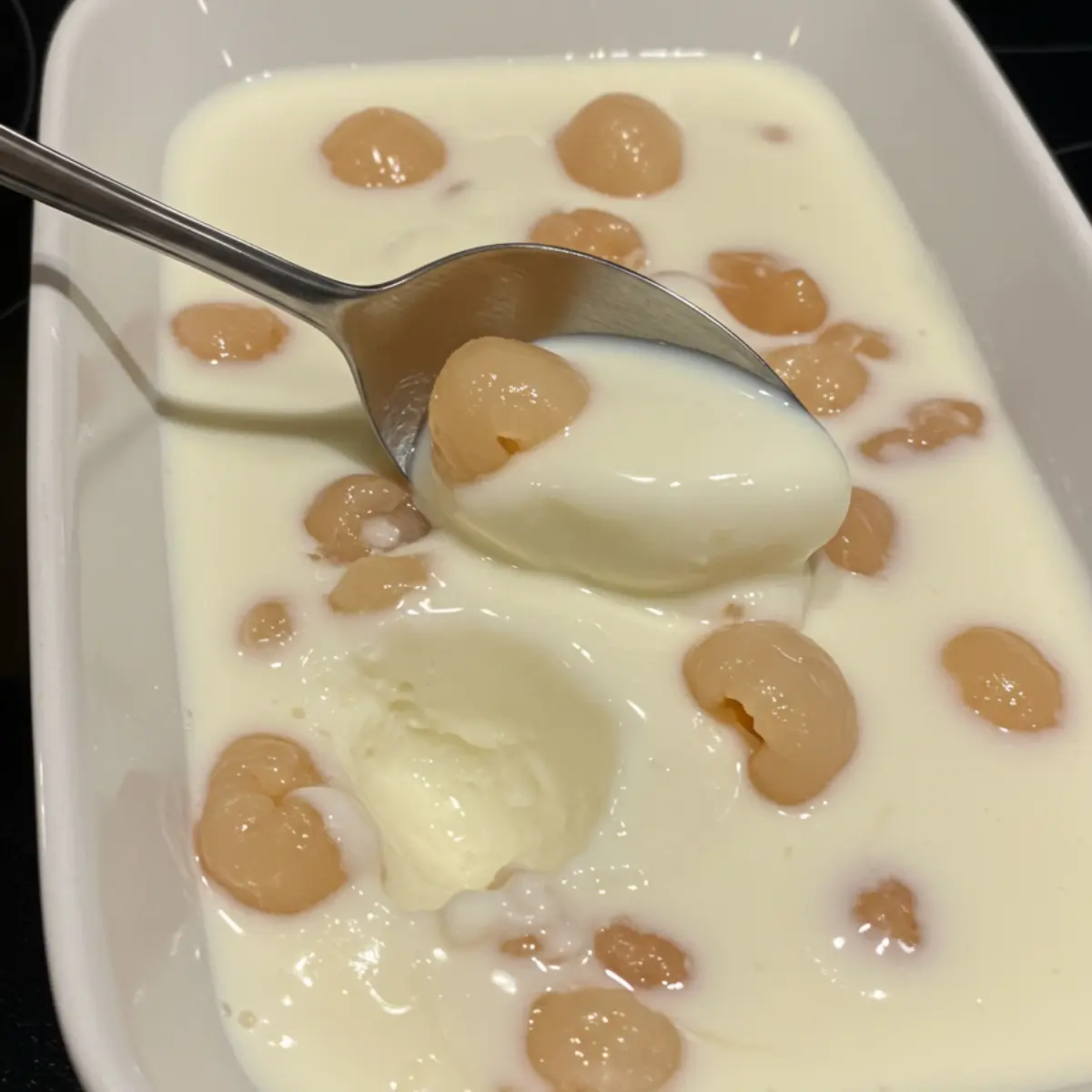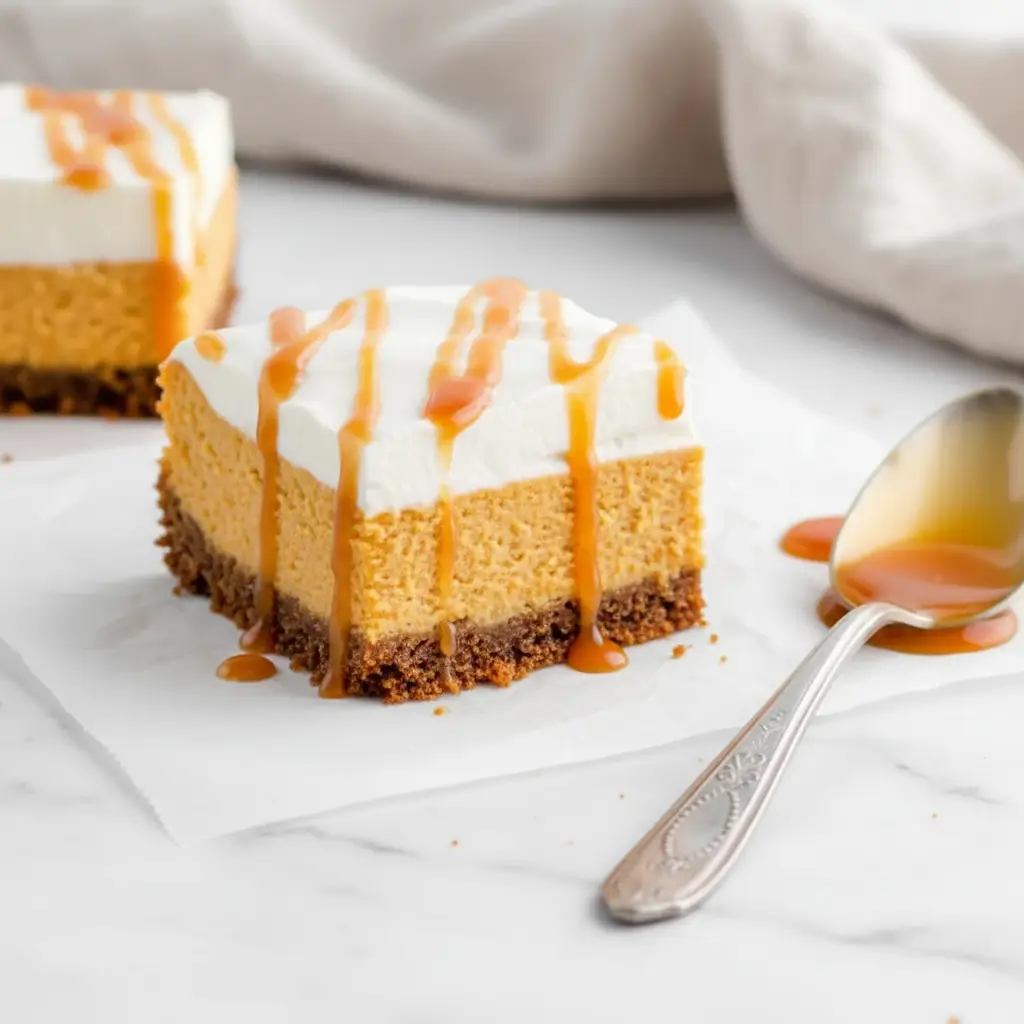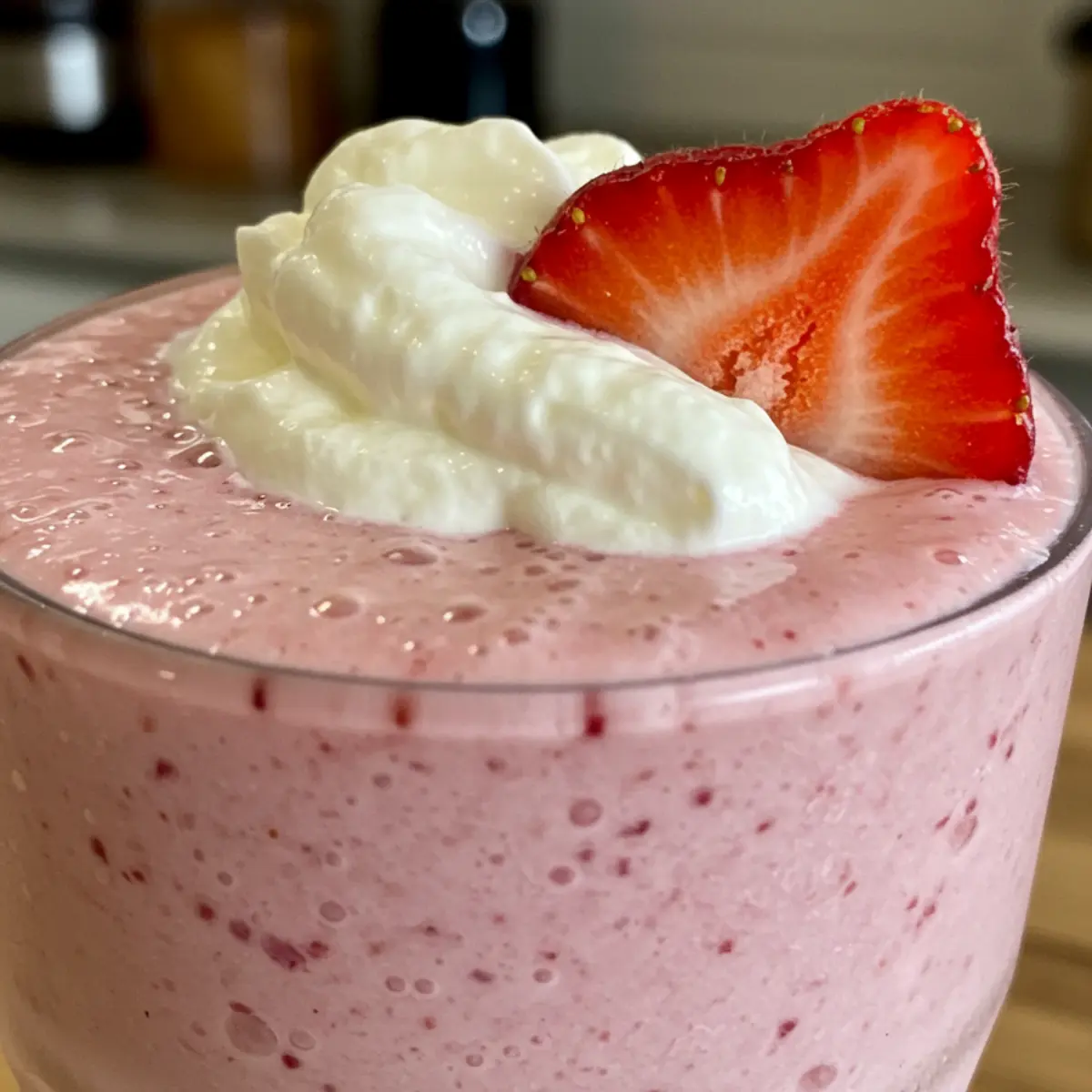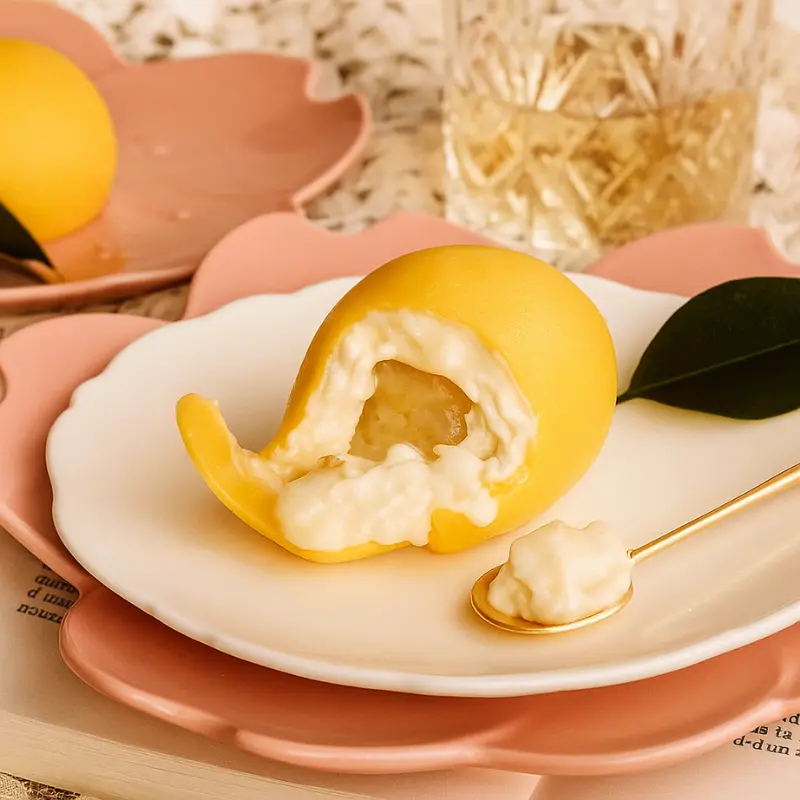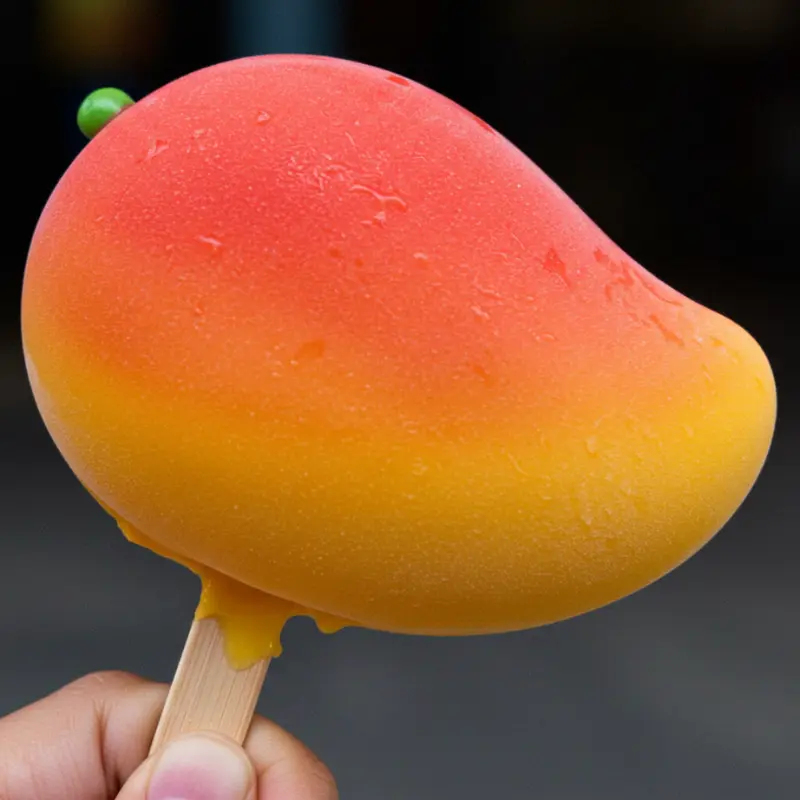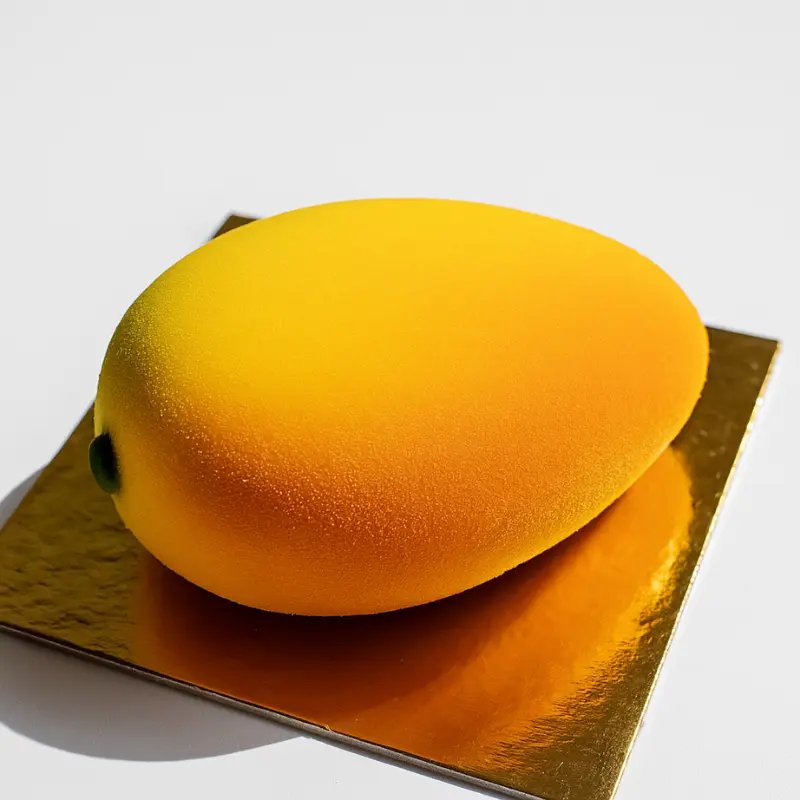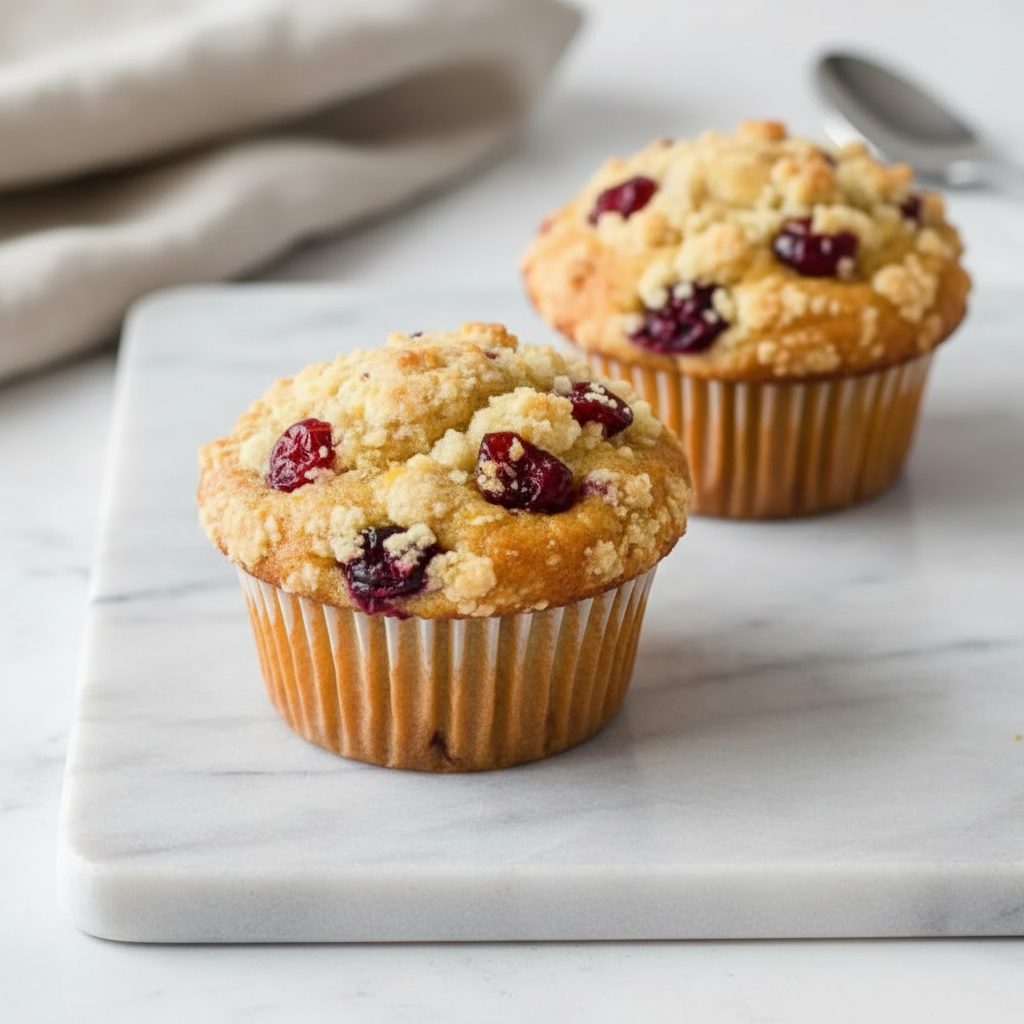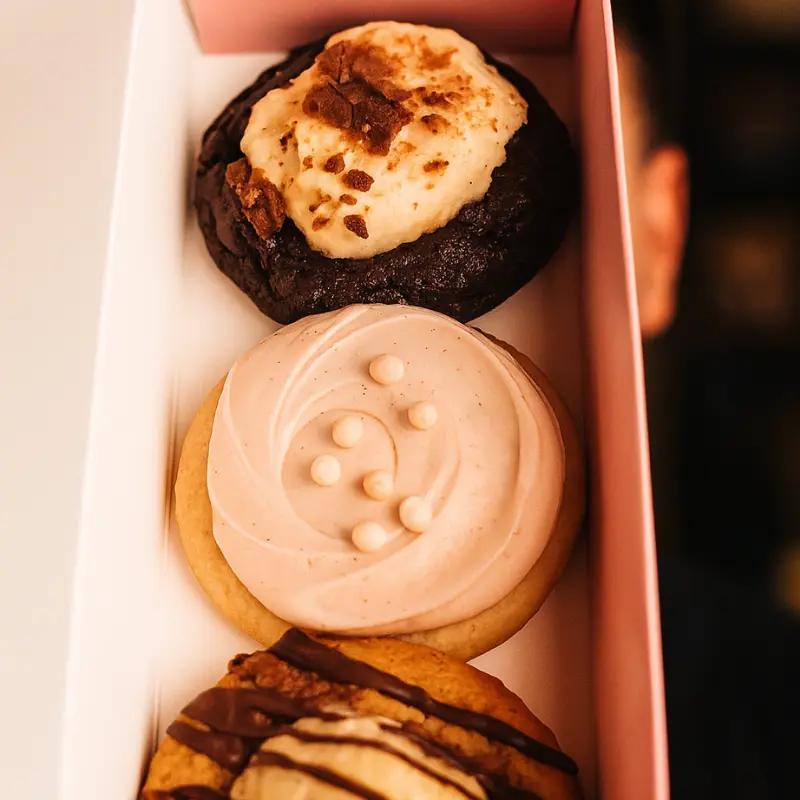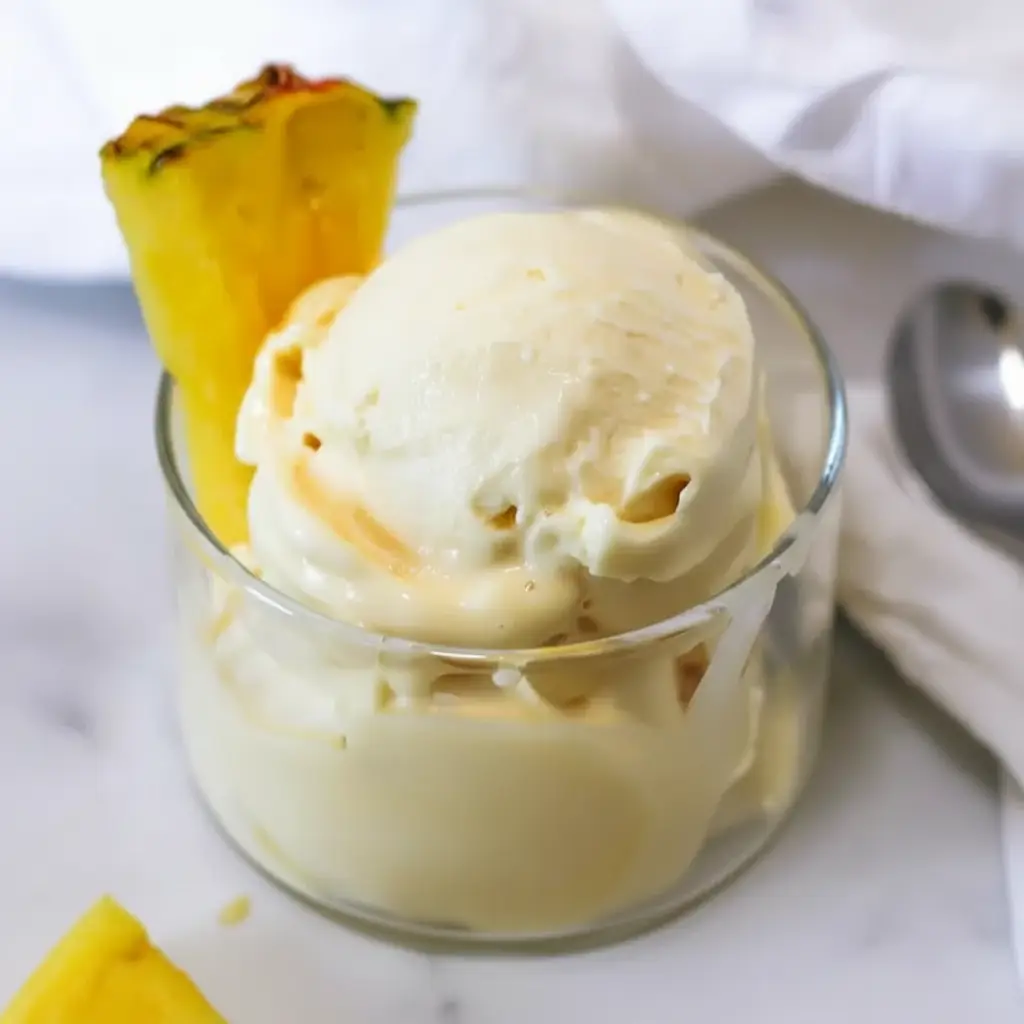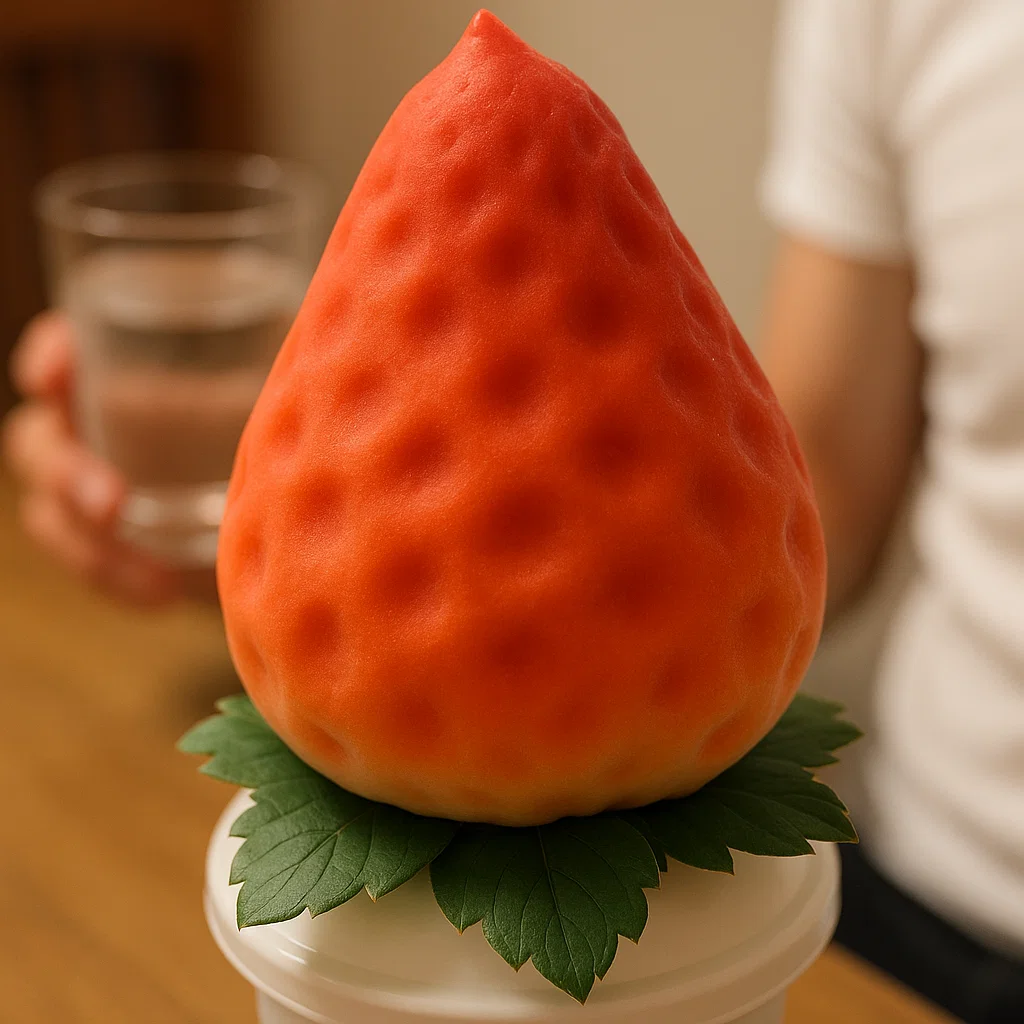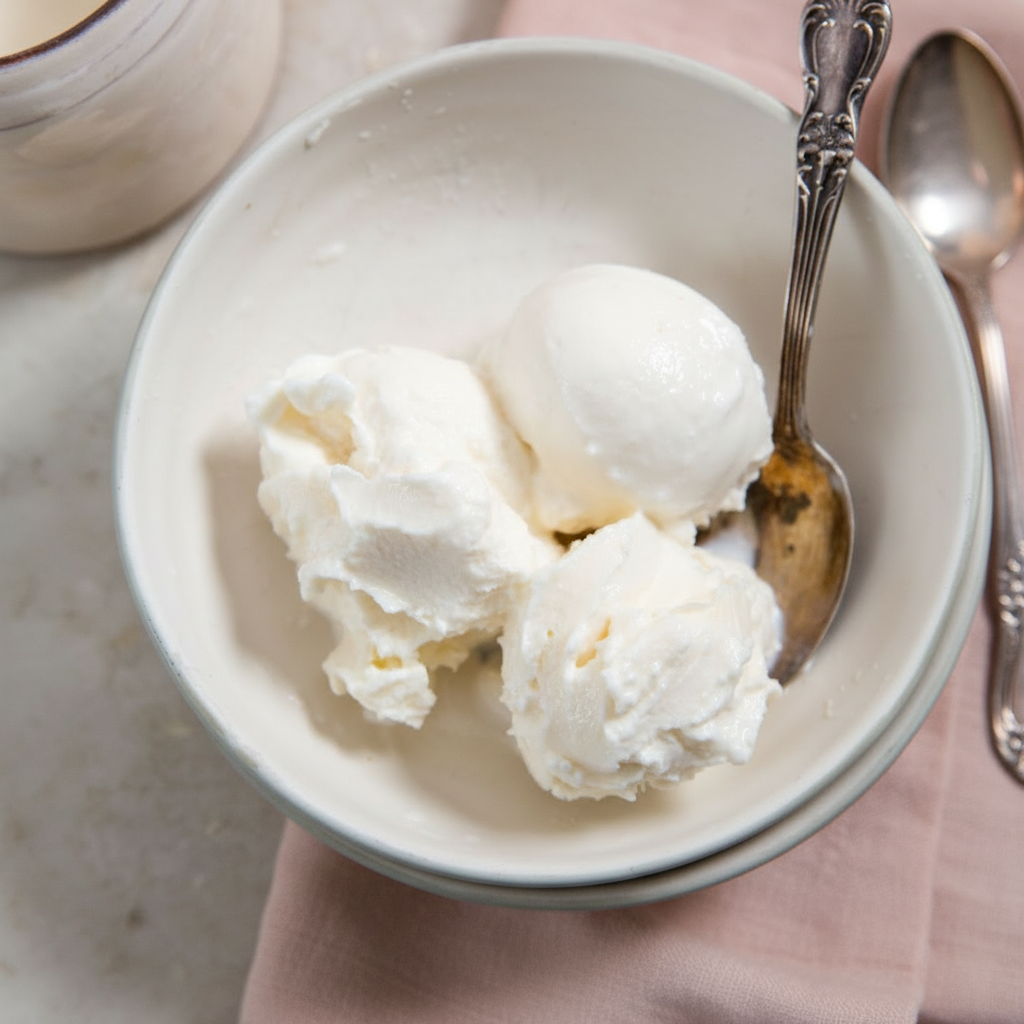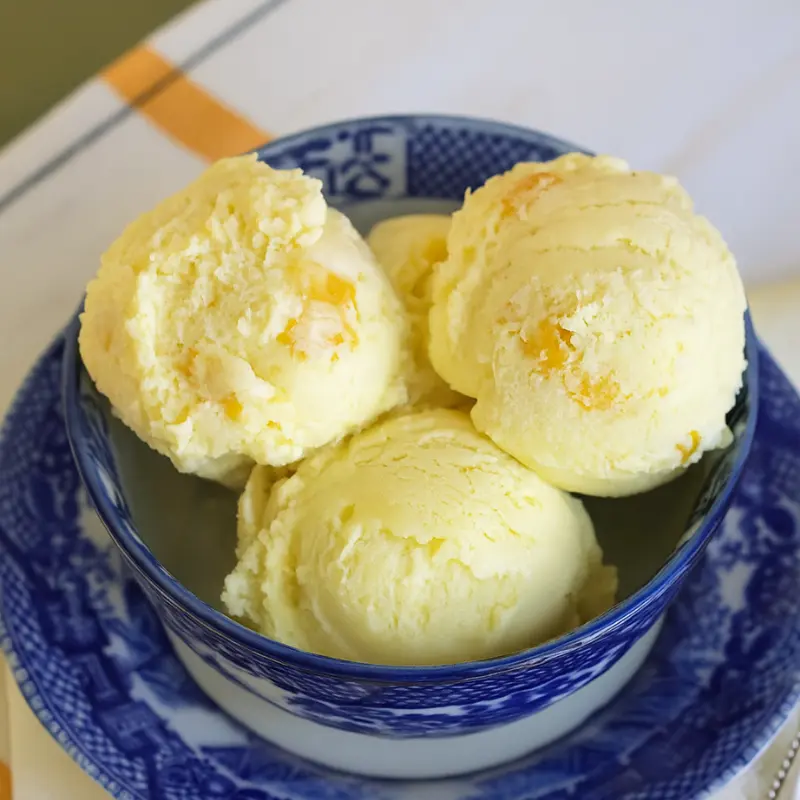Asian mango mousse cake combines the richness of ripe mango with the delicate texture of airy mousse and sponge. It’s a dessert that feels luxurious without being heavy.
From the sweet aroma of fresh mango puree to the soft, melt-in-your-mouth texture, this cake is a sensory delight. In this guide, you’ll learn how to recreate the charm of bakery-style mango mousse cakes at home, with tips for perfect mousse texture, flavor balance, and eye-catching presentation.
Jump To:
Chef-Quality Tools You Need
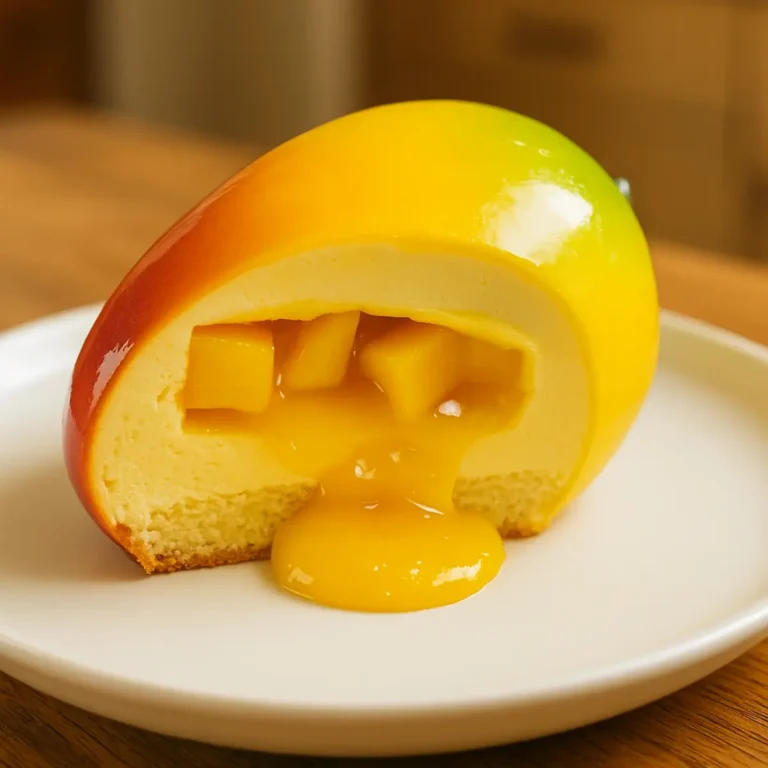
Asian Mango Mousse Cake – Amazing Recipe for Sweet Bliss
An elegant Asian mango mousse cake featuring a mango marmalade insert, mango-infused white chocolate ganache, and a light mousse, finished with a delicate glaze for a professional patisserie look.
- Total Time: 8 hours (including chilling)
- Yield: 6 individual mousse cakes 1x
Ingredients
For the Mango Marmalade Insert:
3 large ripe mangoes, peeled and cubed
2 tablespoons fresh lime juice
80g sugar
5g pectin
1 tablespoon mango liqueur (optional)
For the Mango Ganache Mousse:
200ml heavy cream (first portion)
5–6 lemon verbena leaves (optional)
200g white chocolate, chopped
5g powdered gelatin, softened in water
150ml mango puree
200ml heavy cream (second portion, chilled)
1 tablespoon mango liqueur (optional)
For the Glaze and Coating:
150g white chocolate
150g cocoa butter
Optional: yellow cocoa butter spray for velvet finish
Instructions
1. Peel and cube the mangoes. Place in boiling water for 20 seconds, then in ice water for easy peeling if skin is stubborn.
2. Blend most of the mango into a smooth puree, reserving some cubes.
3. Heat mango puree with lime juice, sugar, and pectin until it reaches a boil. Cook for 2 minutes.
4. Cool to room temperature, then stir in the mango cubes and optional mango liqueur.
5. Pour into half-sphere silicone molds, freeze solid, then join halves to make full spheres. Return to freezer.
6.
7. Heat first portion of heavy cream with lemon verbena until boiling. Cover and infuse for 20 minutes.
8. Strain the cream over chopped white chocolate, letting it melt. Stir until smooth.
9. Add softened gelatin and stir until dissolved. Stir in mango puree, second portion of chilled cream, and optional mango liqueur. Blend well and chill overnight.
10.
11. Whip the chilled ganache until firm but spreadable. Fill silicone molds halfway with mousse.
12. Place frozen mango inserts in the center. Fill molds to the top, ensuring no gaps.
13. Freeze completely until hardened.
14.
15. For coating, melt white chocolate with cocoa butter and dip frozen cakes to create a shell.
16. Optionally, spray with yellow cocoa butter for a velvet effect.
17. Decorate and serve chilled.
Notes
Use very ripe mangoes for a naturally sweet flavor.
If lemon verbena is unavailable, infuse with mint or omit for a pure mango taste.
Mango liqueur adds depth but can be omitted for a non-alcoholic version.
- Prep Time: 1 hour 20 minutes
- Cook Time: 5 minutes
- Category: Dessert
- Method: Chilled, Glazed
- Cuisine: Asian-Inspired
- Diet: Vegetarian
Nutrition
- Serving Size: 1 cake
- Calories: 320
- Sugar: 27g
- Sodium: 40mg
- Fat: 20g
- Saturated Fat: 12g
- Unsaturated Fat: 6g
- Trans Fat: 0g
- Carbohydrates: 32g
- Fiber: 2g
- Protein: 4g
- Cholesterol: 45mg
Asian Mango Mousse Cake Recipe Guide
An asian mango mousse cake is a tropical dessert that blends the natural sweetness of ripe mango with a light and airy mousse. The beauty of this cake is in its balance. You get the creamy texture of the mousse, the softness of a delicate sponge, and the freshness of real fruit. Whether you are making it for a celebration or a weekend treat, the process can be enjoyable if you follow a few key steps.
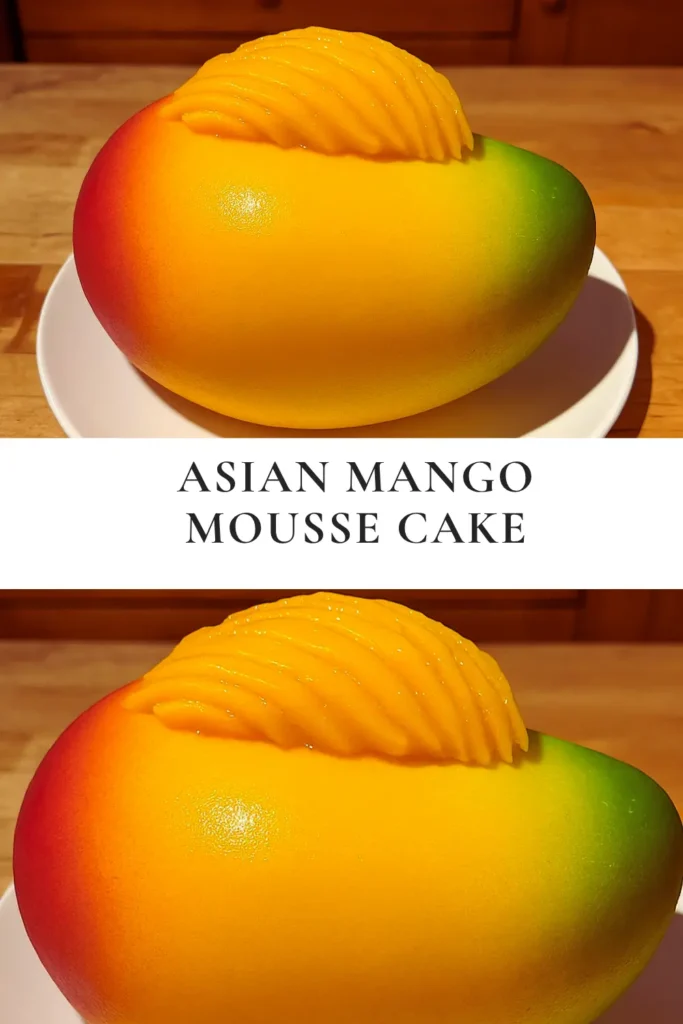
Start with the freshest mangoes you can find. Puree them until smooth, then combine with whipped cream for a light and fluffy filling. A sponge or chiffon base provides structure and absorbs some of the mango flavor without overpowering it. Chill the cake for several hours before serving so the mousse sets perfectly.
Selecting the perfect mango variety
The mango you choose will define the taste of your asian mango mousse cake.
- Alphonso and Carabao mangoes are rich and aromatic.
- Ataulfo mangoes offer a smooth texture and natural sweetness.
- For a slightly tart flavor, try Keitt or Kent mangoes.
Look for fruit that yields slightly to pressure and has a fragrant aroma. Avoid mangoes with large dark spots or wrinkles. Peel and cube the mango before blending to remove any fibrous bits.
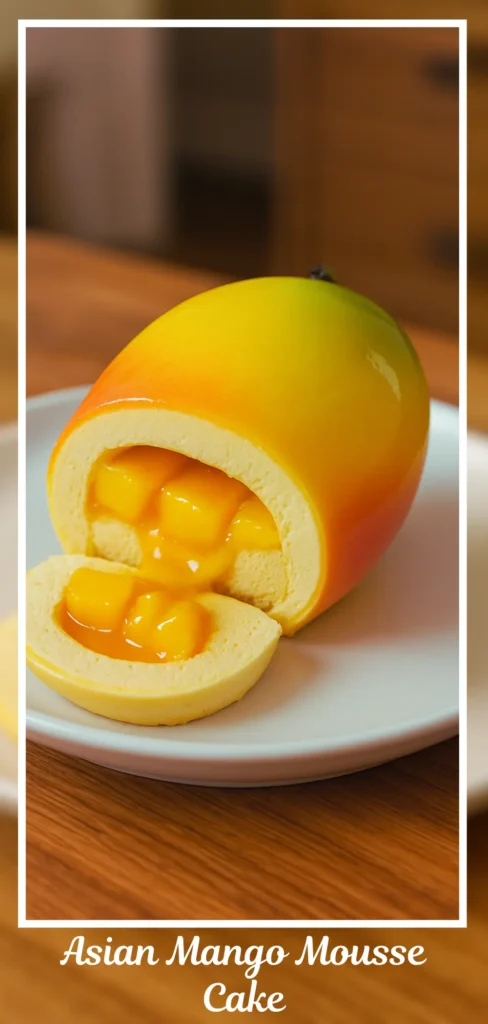
Layering techniques for a light mousse cake
The goal is to keep each layer distinct yet harmonious. Start with a cooled sponge base in your pan. Spread a thin layer of mango puree before adding mousse. This gives a burst of fruit flavor in every bite. Alternate between mousse and sponge if making multiple layers, finishing with mousse on top. Smooth with a spatula for an even finish.
Quick tips for smooth mousse texture
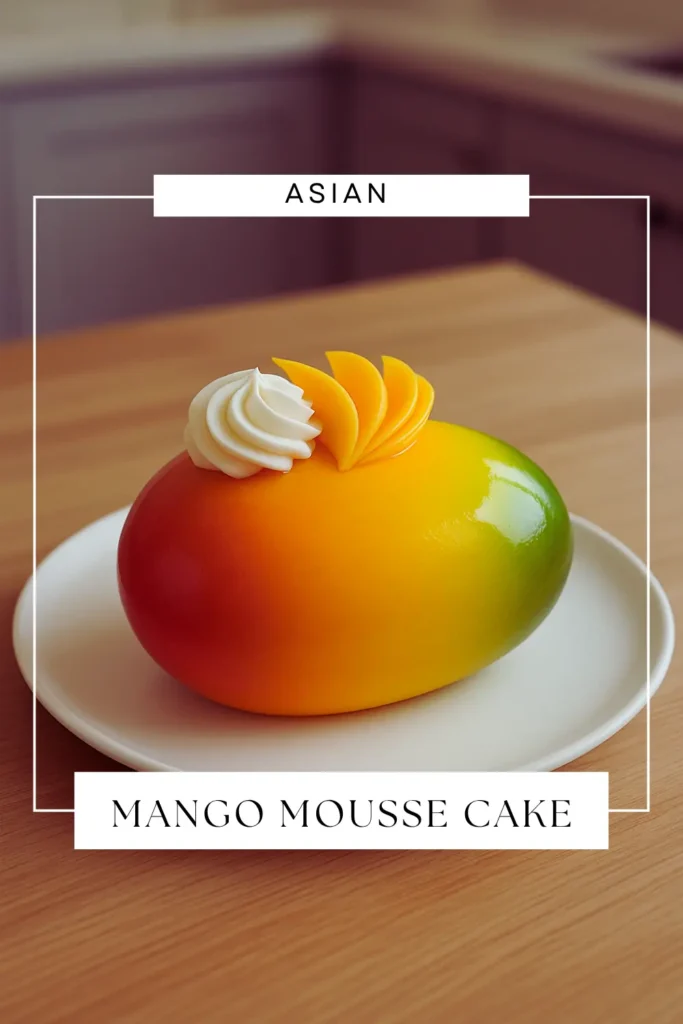
- Whip cream until it forms stiff peaks, but do not overwhip.
- Fold mango puree into whipped cream gently to keep the airiness.
- Chill the mousse mixture before adding it to the cake for a firmer set.
Chinese Mango Mousse Cake at Home
Chinese bakeries are famous for their light and airy fruit cakes, and an asian mango mousse cake in Chinese style captures that delicate balance. The base is usually a fluffy chiffon cake, layered with whipped cream and fresh fruit. When made with mango mousse, it becomes a tropical version of a classic.
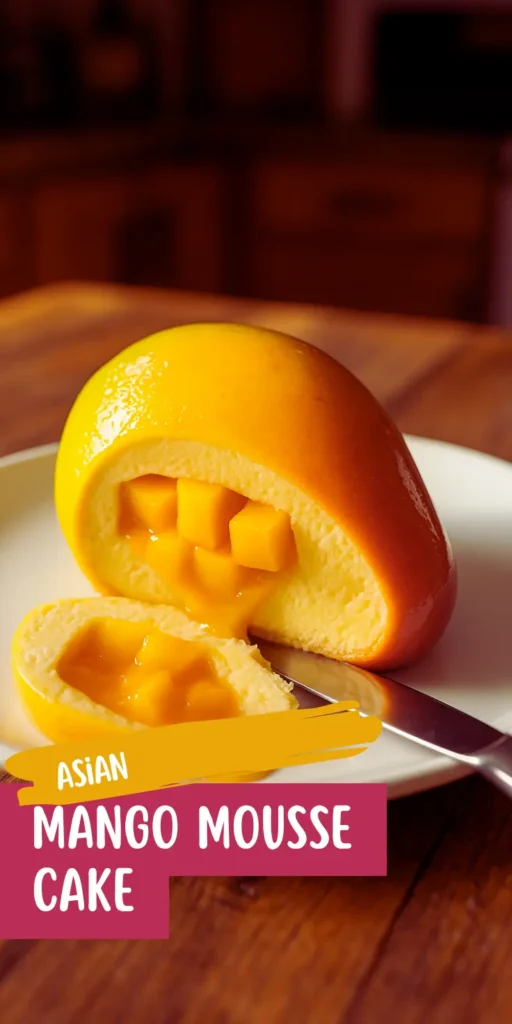
This style is ideal for birthdays or tea-time gatherings. The chiffon base absorbs some of the mango mousse without losing its structure. Fresh slices of mango between the layers add a burst of flavor and a pleasant texture contrast.
Achieving that signature bakery style chiffon base
A chiffon base is made by beating egg whites separately until stiff peaks form, then folding them into the batter. This creates a sponge that is soft yet strong enough to hold mousse. Bake it gently to avoid browning too much, as a pale sponge looks more refined under fruit and cream.
Working with mousse that sets just right
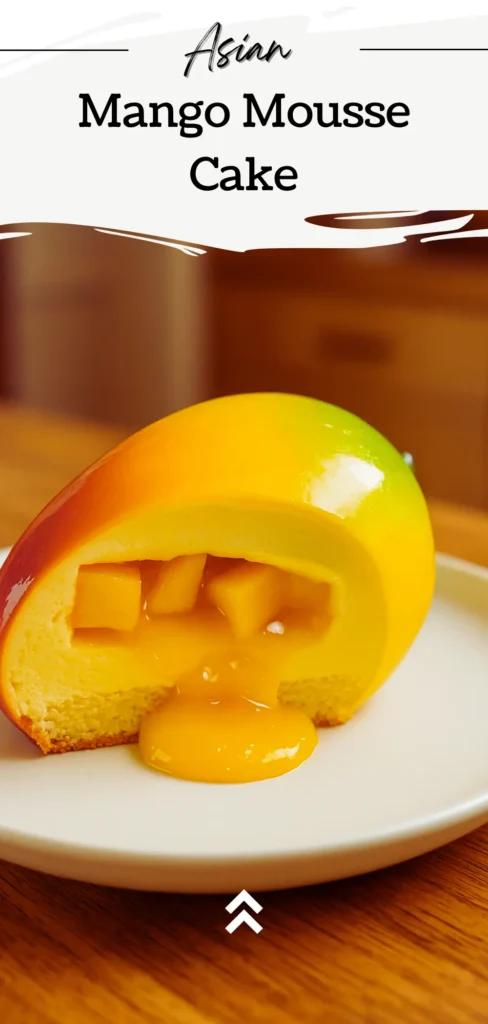
Chinese bakery style mousse is light and not overly sweet. Use fresh mango puree mixed with whipped cream and a small amount of gelatin or agar agar to help it set. Chill the mousse for about 30 minutes before layering so it holds its shape without being too firm.
Decorating with fresh mangoes like pros
Slice mangoes thinly and arrange in a fan or rose pattern on top of the cake. A clear glaze can be brushed over the fruit to keep it shiny and prevent browning. Add a few mint leaves for contrast.
Thai-Inspired Mango Mousse Cake Variations
A Thai twist on asian mango mousse cake brings in bold tropical flavors. Coconut milk, pandan, and sticky rice are often paired with mango in Thai desserts. These ingredients can add richness, fragrance, and texture to your mousse cake.
You might replace part of the whipped cream with chilled coconut cream for a slightly nutty taste. Adding a layer of pandan jelly between the mousse layers introduces a soft chewiness that complements the creamy texture.
Incorporating tropical Thai flavors like coconut or sticky rice
Coconut cream can be whipped and folded into the mousse for a richer taste. Sticky rice can be served alongside the cake or layered between the sponge and mousse for a playful surprise. Sweetened condensed coconut milk can also be drizzled over the top before serving.
Using agar agar instead of gelatin for vegetarian options
Agar agar, made from seaweed, sets firmer than gelatin and is plant based. Use about half a teaspoon per cup of liquid for a mousse that is firm yet creamy. Dissolve it in boiling water or coconut milk before mixing with the mango puree.
Fusion ideas: mango mousse with pandan jelly
Layering pandan jelly with mango mousse gives a visual contrast of green and gold. The floral notes of pandan balance the bright sweetness of mango. Cut the jelly into thin sheets or cubes for easier assembly.
Japanese Mango Mousse Cake Aesthetic
Japanese patisserie style asian mango mousse cake focuses on minimalism, balance, and elegance. The cakes are often small, perfectly proportioned, and designed to be as beautiful as they are delicious.
The sponge base is usually lighter than Western styles, sometimes made with a mix of flour and cornstarch for extra tenderness. The mousse is smooth, with a gentle sweetness that allows the mango flavor to shine without overpowering the palate.
Minimalist, elegant cake designs
A naked cake with visible layers of mousse and sponge has a rustic charm, while a mirrored glaze creates a polished look. Japanese designs favor simplicity, so let the mango’s natural color be the highlight.
Flavor balance: sweet mango vs. soft whipped cream
Mango puree provides the main sweetness, while lightly sweetened whipped cream offers contrast. This balance keeps the cake from being too rich. Taste your puree before using, and adjust sugar accordingly.
Japanese style mousse using yogurt or mascarpone
Adding yogurt to the mousse gives a subtle tang, while mascarpone adds richness. Either option pairs beautifully with mango and gives the cake a creamy yet distinct flavor profile.
Mango Mousse Cake with Agar Agar or Gel Alternatives
For those who avoid gelatin, you can still enjoy a perfect asian mango mousse cake by using agar agar or other thickening agents. These alternatives create a firm yet creamy mousse that holds its shape well. The choice of setting agent can slightly alter the texture, so understanding their differences helps you achieve the result you want.
Agar agar is plant based and sets more firmly, making it popular for vegetarian desserts. Pectin and carrageenan also work well, especially in fruit-based mousses, as they interact nicely with the mango puree. The key is dissolving your setting agent completely before mixing it with the other ingredients, ensuring there are no lumps.
Swapping gelatin for agar agar: ratios and tips
When replacing gelatin with agar agar, use about one teaspoon of agar powder per cup of liquid. Dissolve it in a small amount of boiling water or fruit juice before combining with mango puree and cream. Agar sets at room temperature but benefits from refrigeration for a smooth finish.
How to adjust sweetness and texture when using agar agar
Agar agar sets more rigidly than gelatin, so you might add a little extra whipped cream to keep the mousse soft. Taste your mango puree before setting it, adjusting sugar as needed since firmness can slightly mute sweetness.
Vegan-friendly thickening options (agar, pectin, carrageenan)
- Agar agar for a firm sliceable mousse
- Pectin for a softer, fruitier set
- Carrageenan for a creamy, custard-like texture
No-Bake vs. Baked Mango Mousse Cake Methods
Choosing between no-bake and baked methods for asian mango mousse cake depends on your preference for texture, time, and convenience. No-bake versions are perfect for summer when you want to keep the oven off, while baked versions offer a classic sponge or chiffon base that adds structure.
Both styles deliver a refreshing dessert, but the preparation steps differ. No-bake cakes rely on refrigeration to set the mousse, while baked versions require extra time for cooling before layering with mousse. Consider the occasion and your available time when deciding.
When to choose no-bake for convenience and summer heat
A no-bake cake is ideal when you want something light and quick. You can prepare the mousse and base in the morning and have it ready by evening. Graham cracker crumbs or pre-made sponge layers work well as the foundation.
Tips for baking a sponge cake base that stays moist
Use cake flour for a finer crumb and separate eggs to whip whites before folding them into the batter. Avoid overbaking to maintain a moist texture that complements the mousse.
Chill time vs. bake time: planning your schedule
No-bake cakes need at least 4–6 hours of refrigeration, while baked cakes require cooling before assembly, then additional chilling for the mousse to set. Plan backward from your serving time to ensure every layer has enough time to firm.
Asian Mango Mousse Cake Served at Celebrations
An asian mango mousse cake makes a striking centerpiece for birthdays, weddings, or festive gatherings. Its sunny yellow color, fresh mango aroma, and delicate mousse texture appeal to guests of all ages.
This dessert can be customized to match your event’s theme. You can add edible flowers, gold leaf, or patterned chocolate garnishes to elevate the presentation. Mini individual servings in clear cups also make for a fun and elegant party option.
Birthday and special occasion plating ideas
Serve slices with a drizzle of mango coulis and a dollop of whipped cream. For extra flair, add a fan of fresh mango slices and a sprig of mint on each plate.
Make-ahead prepping and freezing tricks
You can prepare the sponge base and mango puree a day ahead, then assemble the cake the morning of your event. For longer storage, freeze the cake without decoration, then thaw in the fridge overnight before serving.
Combining mango mousse with other desserts like mango float
Pairing the mousse cake with a chilled mango float gives guests two textures of mango dessert. Serve them side by side for a tropical dessert table.
FAQ
What are the ingredients in T&T mango mousse cake?
What is a mango mousse cake?
What is in Porto’s mango mousse cake?
Can you freeze mango mousse cake?
How is mango mousse made?
What is mousse cake made out of?
Share Your Experience
I would love to hear how your asian mango mousse cake turned out. Did you try the asian bakery mango mousse cake look, or go for a simple finish with fresh slices on top? Tell me what worked, what you tweaked, and what you will try next time.
Drop a comment with
- one tip you wish you knew before starting
- your pan size and chill time
- the mango you used and how ripe it was
If you snapped a photo of your meal, share it on Pinterest or Facebook and tag @CookFastRecipes so I can see and feature it in my stories. Let’s keep the quick, healthy snack ideas flowing!


